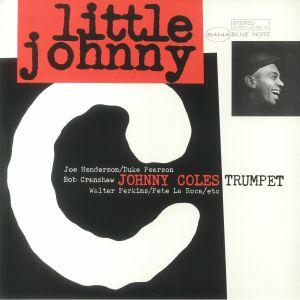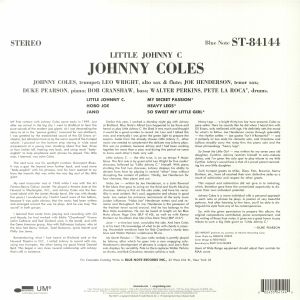Johnny Coles (July 3, 1926, Trenton, New Jersey - December 21, 1997, Philadelphia, Pennsylvania) was an American jazz trumpeter.
Coles spent his early career playing with rhythm & blues groups, including those of Eddie Vinson (1948–1951), Bull Moose Jackson (1952), and Earl Bostic (1955–1956). He was with James Moody from 1956 to 1958, and played with Gil Evans's orchestra between 1958 and 1964, including on the Miles Davis album Sketches of Spain. After this he spent time with Charles Mingus in his sextet which also included Eric Dolphy, Clifford Jordan, Jaki Byard, and Dannie Richmond. Following this he played with Herbie Hancock (1968–1969), Ray Charles (1969–1971), Duke Ellington (1971–1974), Art Blakey (1976), Dameronia, Mingus Dynasty, and the Count Basie Orchestra under the direction of Thad Jones (1985–1986).
Coles, nicknamed "Little Johnny C", recorded as a leader several times over the course of his career.
Johnny Coles never became a star name, but his associations with a half-dozen of the leading jazz figures of the post-war era are significant enough testament to his musical ability.
Whether through circumstances or lack of inclination, Coles seemed content to work with others at the helm throughout his career, but he earned a significant reputation within those parameters. He was never a band-leader of any note, and recorded very few records under his own name. His debut album The Warm Sound, appeared in 1961, while his most significant record as a leader, Little Johnny C, was issued on Blue Note label in 1963.
He taught himself to play trumpet from the age of 10, later adding the customary flugelhorn as well. He studied music at the Mastbaum Vocational School in Philadelphia, and played in army bands during the war years. His initial post-war experience came in commercial bands, notably a rhythm and blues outfit led by saxophonist Eddie "Cleanhead" Vinson, which also included John Coltrane and Red Garland in its ranks.
He continued that rhythm and blues association with bands led by the likes of Earl Bostic and Bull Moose Jackson in the early 1950s, but was also playing in more mainstream jazz settings by that time. They included wroking with drummer Philly Joe Jones in 1951, and a more extended association with saxophonist James Moody in 1956-8. On leaving Moody's band, Coles began working with Gil Evans, whose own standing in the public eye had been greatly elevated by the success of his collaborations with Miles Davis.
Coles was a very different trumpeter in stylistic terms, but Evans admired his dry, economical sound and his ability to exploit musical space with just the right placement of notes, a virtue he did share with Davis.
Those qualites are evident in Coles's contributions to several of Evans's important recordings, including the imaginative re-workings of classic jazz material in the New Bottle Old Wine (1958) and Great Jazz Standards (1959) albums, and the seminal Out of the Cool, recorded in 1960 and regarded as Evans's masterpiece.
Coles's rounded tone and controlled, almost austere lyricism, combined with his ability to find his own means of individual expression within the context his leader was trying to create, make that record a highlight of his six year tenure with the Gil Evans Orchestra, which ended when he was recruited by Charles Mingus for a tour of Europe in 1964, in a sextet which also featured saxophonists Eric Dolphy and Clifford Jordan, and pianist Jaki Byard.
Sadly, we will never know what might have come of that association, or that fascinating combination of talents. Coles was taken ill early on the tour, and had to return home. He never rejoined the Mingus band, and missed most of the live recordings made on the tour, although those on which he did feature (which includes a concert with the sextet recorded at Town Hall, New York, just before the tour began) have left an intriguing glimpse of what might have been.
He continued to play and record in New York, including albums with pianist Duke Pearson and the Brazilian singer Astrud Gilberto. In 1968, he joined the first incarnation of pianist Herbie Hancock's ground-breaking sextet, and is featured on The Prisoner (1969).
In 1969, Coles went all the way back to his early rhythm and blues roots when he joined the Ray Charles Orchestra, an association which lasted until the trumpeter was recruited by Duke Ellington in 1971. He remained a fixture in the Ellington Orchestra until 1974, then spent another two years with Ray Charles.
In the 1980s, his versatility and experience remained in demand. He made a rare album under his own name, New Morning, for the Dutch-based Criss Cross label in 1982, and toured with several tribute and revival bands, including the Count Basie Orchestra, Mingus Dynasty, and a project devoted to the music of pianist and arranger Tadd Dameron.
Coles retired from performing in 1989.
Read more on Last.fm. User-contributed text is available under the Creative Commons By-SA License; additional terms may apply.


